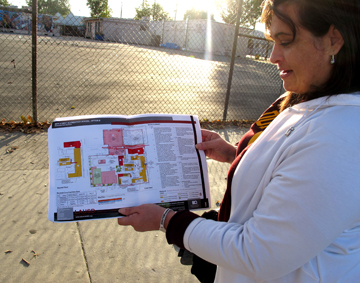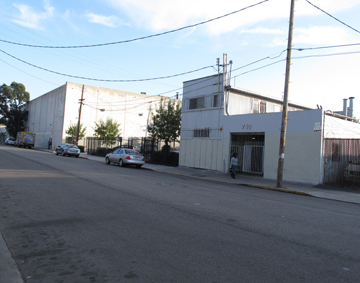 Palace Plating, the chrome plating facility responsible for releasing toxic chemicals into the environment surrounding 28th Street Elementary School, will permanently shut down by December 31, putting a six year-old lawsuit against the company to an end.
Palace Plating, the chrome plating facility responsible for releasing toxic chemicals into the environment surrounding 28th Street Elementary School, will permanently shut down by December 31, putting a six year-old lawsuit against the company to an end.
Under the terms of the settlement approved by a Los Angeles Superior Court judge on November 2, the company must remove all on-site hazardous waste within 90 days and pay the Los Angeles Unified School District $750,000 in restitution for the clean up as a result of contamination at the school.
This is a victory for Martha Sánchez, a community resident and parent of children who were attending 28th street elementary school at the time. The settlement means the end of an exhausting, eight-year battle against a facility she believes was harming her children and her community.
Many community members and even Sánchez’s own family told her that there was no way the lawsuit was going to win. So when she received the news of the settlement she says it felt “like it’s mission accomplished—yes, we did it. That makes me feel proud of the work.”
The fight began in 2003, when city officials held a community meeting informing residents that the plant was responsible for releasing chemicals that had been known to cause cancer.
Because Los Angeles is already polluted, Sánchez recalls residents were told that they were already exposed to these chemicals and that it was safe. But she says her children had been healthy until she moved to the area. That’s when they started experiencing health problems.
 At the community meeting where city officials informed Sánchez of the carcinogenic chemicals being released, she voiced her concerns. “When I put my kids in this school, they started complaining about a lot of things that I think are related to these chemicals.”
At the community meeting where city officials informed Sánchez of the carcinogenic chemicals being released, she voiced her concerns. “When I put my kids in this school, they started complaining about a lot of things that I think are related to these chemicals.”
After this meeting, Sánchez began investigating Palace Plating’s effects on 28th Street Elementary School students. She began collecting evidence of student health problems. She interviewed teachers, who told her they were sending five or six students to the nurse every day with symptoms that could have been caused by the chemicals in the air. She would stand outside the elementary school and interview parents, documenting every symptom and case. She remembers that many of the children had headaches, bloody noses, vomiting, and rashes.
She remembers the awful air quality surrounding the school as she waited outside the building to pick up her children. “When they were operating, all the gasses came to you, as if you were waiting in a car shop. All the mist came to you, and you started feeling itchy and burning and in a few minutes you were only full of rashes… And it was every single day. It was really really terrible.”
 Sánchez says she took the evidence she collected to the health department and other city agencies asking them to start an investigation. She says they told her the evidence she produced was not reliable and she didn’t have the legal authority to make the claims. That’s when Sánchez began to contemplate legal action.
Sánchez says she took the evidence she collected to the health department and other city agencies asking them to start an investigation. She says they told her the evidence she produced was not reliable and she didn’t have the legal authority to make the claims. That’s when Sánchez began to contemplate legal action.
“This is evidence, and if you do not take the responsibility to look at my evidence, you are perpetrating a problem, and I’m going to do something legal to force you to do so,” recalls Sánchez, explaining her run-in with the health department.
In 2006, city inspectors found chromium, one of the chemicals produced by the plant, was being released into the City’s sanitary sewer system. They also discovered that cleaning solvent tetrachloroethylene, originating from underneath the plant, was impacting the air quality in and around the 28th Street Elementary School, and that there were hazardous levels of cadmium and chromic acid on the property.
Chromium can cause a series of health problems including nosebleeds, bronchitis, kidney and liver damage, asthma, dermatitis, and lung cancer.
 Feeling they had run out of options, Sánchez, about 50 families, and over a dozen teachers eventually filed a lawsuit against the school.
Feeling they had run out of options, Sánchez, about 50 families, and over a dozen teachers eventually filed a lawsuit against the school.
“I could scream as much I can, I could protest as much as I can, I could bring people to community action. I found out there was no other way than facing a lawsuit—civil action,” says Sánchez.
She’s glad the legal action is over. “It made me feel happy. Finally I’m screaming and laughing now. Finally, because I still can’t believe it.”
LAUSD has plans to develop a new playground for the children in the area, and soon, new affordable housing will transform the strip of land. Sánchez hopes the new apartments and renovations already being constructed down the block will help build a better community.
In the meantime, she’s thankful for the lessons and memories her children were able to experience as part of this movement.
“They became part of the lawsuit that changed a poor community… So that’s my inspiration. I have to pass the torch to the next generation.”















Speak Your Mind